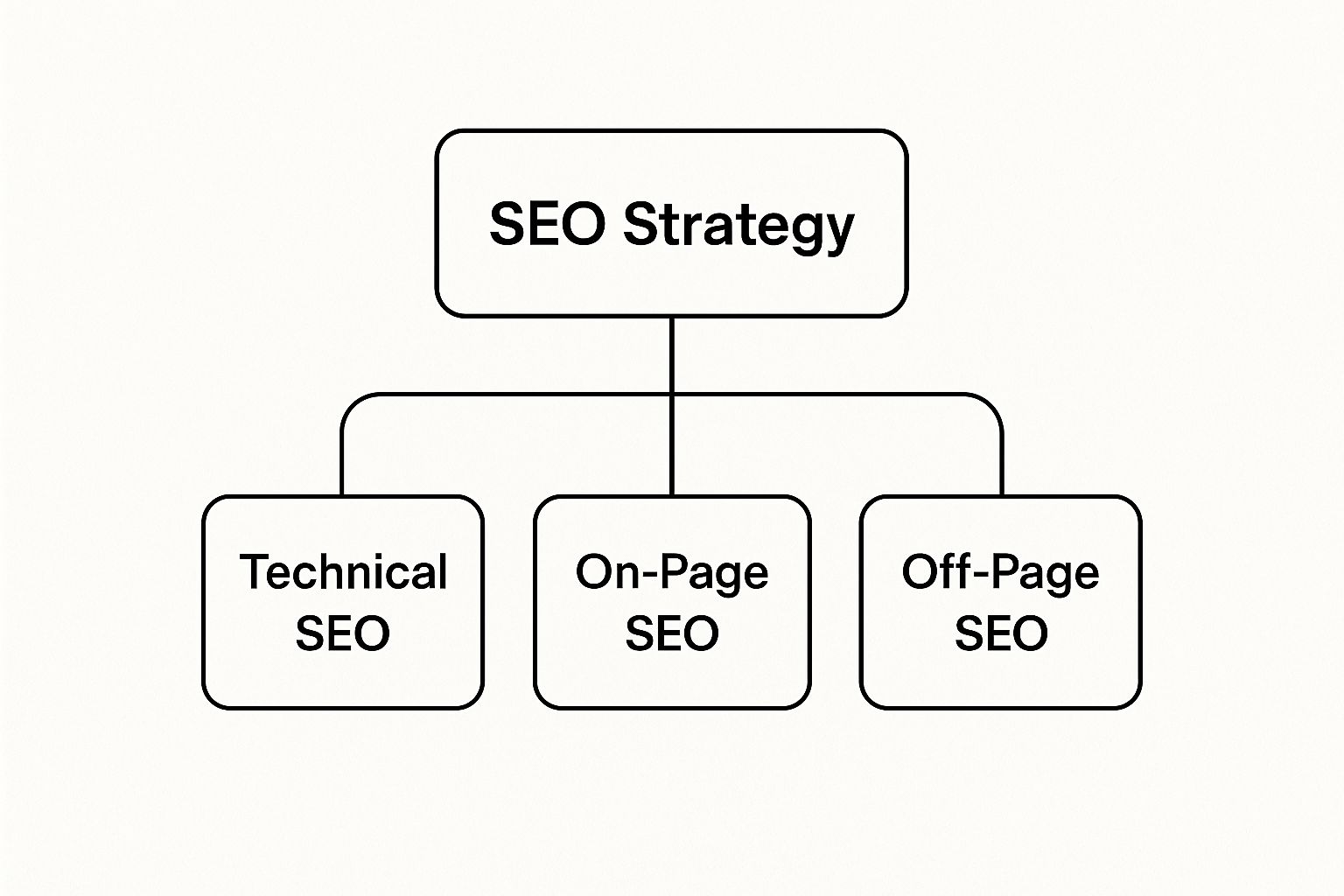SEO management is the continuous process of getting a website to rank higher in search engines like Google to attract the right kind of traffic. It's not a set-it-and-forget-it task. Think of it as an ongoing strategy that blends technical tune-ups, content creation, and building your site's reputation to drive real, sustainable growth.
Unpacking SEO Management: A Fitness Plan for Your Website

Let’s think of your website as a professional athlete. One great workout isn’t enough to win a championship. In the same way, a one-off "SEO project" won't keep you at the top of the search results for long. SEO management is the consistent training regimen—the fitness plan and the smart nutrition—that keeps your website in peak condition to compete and win.
This ongoing commitment ensures your site doesn’t just rank well today. It helps you adapt to Google's constant algorithm updates, stay ahead of the competition, and meet the ever-changing needs of your audience. Before you can really appreciate its impact, it helps to understand the fundamentals of What Is Search Engine Optimization and see how it fuels your organic growth.
The Three Pillars of a Strong Strategy
A solid SEO management plan is built on three core pillars. They all have to work together. If you neglect one, the whole structure gets wobbly—much like an athlete who has strength but zero endurance.
These three areas form the foundation of any successful strategy, ensuring a well-rounded and resilient approach to search visibility.
The Three Pillars of SEO Management
| Pillar | Core Focus | Primary Goal |
|---|---|---|
| Technical Health | Site speed, mobile-friendliness, crawlability, security. | Make it easy for search engines to find, understand, and index your website without any issues. |
| Content & On-Page SEO | High-quality articles, keyword optimization, user intent. | Create relevant, valuable content that directly answers what your audience is searching for. |
| Authority & Off-Page SEO | Backlinks, brand mentions, online reputation. | Build trust and credibility with both search engines and users by earning links from other reputable sites. |
By balancing all three, you create a powerful, self-reinforcing cycle where great technicals help your content get seen, and great content earns the backlinks that build your authority.
SEO management transforms your website from a static digital brochure into a dynamic, lead-generating asset. It's the strategic oversight that connects technical fixes and content creation to tangible business goals like increased traffic, leads, and sales.
This holistic view is what separates a reactive, project-based mindset from a proactive, growth-driven one. If you want to dig deeper into the basics, our guide on what search engine optimization is all about offers a great starting point. At the end of the day, consistent management is about making sure every part of your digital presence works together to deliver results that last.
The Core Components of an SEO Strategy
Great SEO isn't about finding one magic bullet. It’s a complete strategy built on three distinct, yet deeply connected, pillars. I like to think of it like building a house: you need a rock-solid foundation (Technical SEO), a well-designed interior with everything in the right place (On-Page SEO), and a great reputation in the neighborhood that makes people want to visit (Off-Page SEO).
If any one of these is shaky, the whole structure suffers.
This visual helps break down how all three parts come together to form a truly effective SEO plan.

As you can see, real success comes from a unified effort across all three areas. You simply can't get meaningful, lasting results by focusing on just one.
Technical SEO: The Foundation
Technical SEO is all the work you do under the hood to help search engines find, crawl, and index your website without any trouble. It’s the essential groundwork that makes sure your content even has a fighting chance to rank.
Without a strong technical foundation, even the most brilliant blog post or perfectly designed landing page might as well be invisible.
Some of the most common (and crucial) technical tasks include:
- Improving Site Speed: Making sure your pages load in a snap. Slow sites don't just frustrate users; they get penalized by search engines.
- Mobile-Friendliness: Ensuring your website looks and works great on a smartphone is no longer optional—it's a major ranking factor.
- XML Sitemaps: This is like handing Google a map of your site, making it easy for its crawlers to find all your important pages.
- Site Security (HTTPS): An encrypted site protects user data, which builds trust with both your visitors and search engines.
It might not be the most glamorous part of SEO, but it's absolutely non-negotiable for success.
On-Page SEO: The Content and Structure
On-page SEO is all about optimizing the things people actually see and interact with—your content, headlines, images, and the underlying HTML code. This is where you directly connect what you offer with what your audience is searching for.
Think of it as the art of making every page on your site as relevant and valuable as possible.
A huge part of on-page SEO is creating content that doesn't just stuff in keywords but truly answers the questions your audience has. It’s about providing real value that makes them stick around.
To really nail this, you need to go beyond the obvious search terms. Mastering strategies for long-tail keyword research helps you find those specific, high-intent phrases that your competitors often overlook. This is how you attract people who are much closer to making a decision.
Off-Page SEO: The Reputation and Authority
Finally, off-page SEO covers all the actions taken outside of your website to boost your rankings. This pillar is all about building your site's reputation, authority, and trustworthiness across the web.
Search engines view high-quality backlinks from other respected websites as votes of confidence. Each one tells Google that your content is valuable and worth showing to more people.
But building authority is more than just collecting links. It also involves:
- Brand Mentions: Simply getting your brand talked about on social media, forums, and other websites.
- Guest Blogging: Writing articles for well-known blogs in your industry to build your profile.
- Online Reviews: Encouraging positive reviews on platforms that matter to your customers.
When you put them all together, these three components create a powerful cycle. A technically sound site gets your amazing content discovered, and that great content earns the links and mentions that build your authority, which in turn pushes you higher and higher in the search results.
How a Real SEO Management Campaign Unfolds

It’s one thing to know what SEO is, but it’s another to see how a real campaign actually works day-to-day. Far from being a chaotic mess of random tactics, a proper SEO management campaign is a structured, cyclical process. It’s methodical.
Think of it as a flywheel. Each phase builds on the last, creating a feedback loop that gains momentum over time and gets smarter with every rotation. This is how you turn abstract goals into a repeatable system for genuine growth.
Phase 1: The Deep-Dive Audit and Discovery
Every solid SEO campaign kicks off with a thorough health check of your website. The initial SEO audit is where we pop the hood and inspect everything, uncovering technical glitches that are holding you back and identifying golden content opportunities you might be missing. We’re talking about a deep analysis of your site’s architecture, page speed, and mobile-friendliness.
At the same time, we get into keyword research. This isn't just about finding popular terms; it's about pinpointing the exact phrases your ideal customers are typing into Google when they're ready to buy. This crucial discovery work gives us a clear baseline, a starting point from which we can measure all future progress.
Phase 2: Building the Strategic Roadmap
Once we know exactly where you stand, it's time to map out the journey ahead. This is where we translate all those audit findings and keyword insights into an actionable strategy with crystal-clear goals. Are we trying to boost qualified leads by 15% in the next six months? Or maybe the goal is to become the go-to result for a specific local service?
With a clear objective, we can build a prioritized action plan. This roadmap details the specific initiatives for the coming months, which usually looks something like this:
- Technical Fixes: A schedule for squashing the critical site errors we found in the audit.
- Content Calendar: A game plan for the blog posts, landing pages, and other content we need to create.
- Link-Building Targets: A wish list of authoritative websites we want to earn backlinks from to build your credibility.
This roadmap ensures every single task we perform is intentional and directly tied to your business goals. No wasted effort.
Phase 3: Execution and Ongoing Work
This is where the rubber meets the road. The execution phase is the heart of SEO management—the continuous, hands-on work of bringing the strategy to life. It’s the steady rhythm of creating and publishing top-notch, optimized content, making technical tweaks to the site, and actively building your website’s authority through outreach.
This isn't a "set it and forget it" kind of deal. It's a constant cycle of creating, optimizing, and promoting. Consistency is everything here, as search engines reward sites that are actively updated with fresh, valuable information.
It’s this consistent, methodical effort that builds on itself, creating lasting authority and momentum.
Phase 4: Tracking Performance and Reporting Back
The final piece of the puzzle is tracking what’s happening and reporting on it. Using tools like Google Analytics and Google Search Console, we keep a close eye on the key performance indicators (KPIs) that matter—organic traffic, keyword rankings, and, most importantly, conversions. This data tells us exactly what’s working and what needs a rethink.
Regular reports turn all that complex data into straightforward insights, showing you the progress and allowing us to make smart adjustments to the strategy. It’s important to have realistic expectations; seeing a positive return on investment from SEO typically takes between 6 to 12 months. But the payoff can be huge. Some industries, like real estate, have seen a staggering ROI of 1,389% from their long-term SEO efforts. You can learn more about what results to expect from SEO on seo.com.
This data-driven feedback loop is what makes SEO management so effective—it ensures the strategy is always evolving and improving to drive sustainable growth.
The Essential Toolkit for Modern SEO Management
Trying to manage SEO without the right tools is like trying to navigate a ship in the dark without a compass. You might drift in the right direction for a while, but you’re mostly just guessing. A modern SEO pro leans on a specific set of tools to diagnose problems, find opportunities, and track whether their work is actually paying off.
These tools are what separate a data-backed strategy from wishful thinking. They turn mountains of raw data into clear, actionable next steps.
All-in-One SEO Platforms
Think of platforms like Ahrefs and Semrush as the command center for your entire SEO operation. They give you a high-level view of almost everything that matters, from tracking your keyword rankings and analyzing your backlink profile to spying on your competitors and running technical site audits.
The real power of these platforms is how they connect different parts of your campaign. You can see how a new piece of content is earning backlinks or how fixing a technical issue improves your keyword positions, all from one dashboard.
A rookie mistake is looking at SEO metrics in isolation. The beauty of an all-in-one tool is that it helps you connect the dots between your site’s technical health, your content’s performance, and your authority online. It shows you the whole ecosystem, not just one piece of it.
Specialized Tools for Specific Jobs
While the big platforms are fantastic for a broad overview, sometimes you need a magnifying glass, not a telescope. Specialized tools are built to do one or two things incredibly well, giving you a depth of insight that the all-in-ones can't always match.
- Technical Auditing: A tool like Screaming Frog is like a CT scan for your website. It crawls every single URL to uncover hidden problems like broken links, redirect chains, and duplicate content that could be holding you back.
- Keyword Research: Finding the exact phrases your customers are searching for is a science. This is where dedicated tools shine, helping you uncover content gaps and high-value topics. If you want to go deeper, check out these keyword research best practices that drive real results.
The Non-Negotiable Analytics Duo
Finally, there are two tools that are absolutely essential—no exceptions. Google provides them for free, and they offer the ground-truth data for how your site performs in the real world.
Google Analytics is all about what happens after someone clicks on your site. It answers questions like: Which pages are most popular? How long do people stick around? Are they filling out forms or making purchases?
Google Search Console, on the other hand, gives you direct feedback from the search engine itself. It shows you which search terms brought people to your site, what your click-through rate is, and whether Google is having trouble crawling or indexing any of your pages. Using them together is how you close the loop and make truly informed decisions.
Measuring SEO Success with the Right KPIs

You can't manage what you don't measure. In SEO, that means getting real about what success actually looks like. It’s not about chasing vanity metrics like raw page views; it’s about tracking the Key Performance Indicators (KPIs) that connect directly to your business goals. Think of KPIs as the bridge between your day-to-day SEO work and tangible, bottom-line results. They’re how you prove your investment is paying off.
Instead of just spitting out numbers, good KPIs tell a story. They reveal your website’s health, how visible you are to potential customers, and whether you're attracting the right kind of audience. They are your scorecards, showing you what’s working and what needs a complete rethink.
Core Performance KPIs
These are the big-picture metrics. They give you a quick, clear snapshot of your campaign's progress and are the first place you should look to see if you're moving in the right direction.
- Organic Traffic Growth: This one's straightforward—it’s the total number of people finding your site through unpaid search results. A steady climb here is the clearest sign that your visibility is growing.
- Keyword Ranking Improvements: Are you showing up for the searches that matter? Tracking your position for high-intent, commercially valuable keywords tells you if you're capturing your audience's attention when they're ready to act.
- Conversion Rate from Organic Visitors: This is the ultimate test. It measures how many of those organic visitors actually do what you want them to do, whether that’s filling out a form, buying a product, or signing up for your newsletter.
A higher conversion rate proves you're not just pulling in random visitors, but attracting people who are genuinely interested in what you offer. The impact is huge. On average, organic search drives 33% of all website traffic, and the return is staggering: SEO boasts a 14.6% conversion rate, while traditional outbound methods like cold calls lag far behind at just 1.7%. You can dig into more data on the state of organic marketing on conductor.com.
Good SEO management is all about tying your work to revenue. You have to measure outcomes, not just activities.
Website Health and Authority KPIs
Beyond the immediate performance numbers, you need to keep an eye on the metrics that signal your website’s underlying strength and credibility. Think of these as leading indicators—they tell you where you're headed.
A strong backlink profile and high domain authority are like a rising tide that lifts all your other SEO efforts. They send a powerful signal to Google that your site is a trustworthy source, which makes everything else easier.
To keep a pulse on these foundational elements, you should monitor:
- Domain Authority (DA) or Domain Rating (DR): This is a score from 1 to 100 that predicts how well your site will rank. A higher score means more authority. Simple as that.
- Backlink Profile Quality: It’s not just about how many sites link to you, but who is linking to you. Earning links from relevant, reputable sites is like getting a powerful vote of confidence.
- Crawl Errors: You can find these in Google Search Console. They signal technical glitches that stop search engines from properly accessing and indexing your site. Keeping this number as close to zero as possible is non-negotiable for good site health.
When you combine these health indicators with your performance KPIs, you get the full story. You can see how fixing technical issues boosts your organic traffic or how building your authority leads to better keyword rankings. This data is the backbone of any solid report, and you can learn more about building them in our guide to what is SEO reporting.
The Real Business Impact of Strategic SEO
So, what's the real payoff for all this work? Thinking of SEO management as just a way to climb Google's rankings is missing the bigger picture. When done right, it turns your website from a passive online brochure into a powerful, predictable engine for growth that works for you 24/7.
Unlike paid ads, which vanish the second you turn off the budget, a solid SEO strategy builds a sustainable advantage. Every piece of optimized content, every hard-earned backlink, is a long-term asset. It's an investment that keeps paying dividends in the form of qualified traffic, month after month, without a constant cost-per-click.
Building Lasting Brand Authority
A powerful SEO presence does so much more than just drive traffic—it builds unshakable brand credibility and trust. When your business consistently shows up with the right answers to your customers' questions, you stop being just another vendor. You become the go-to authority in your space.
That kind of visibility is everything. The top result on Google gets nearly 30% of all clicks, and a staggering 75% of people never scroll past the first page. Proper SEO management puts you right where your customers are looking, cementing your reputation as a leader. If you want to dive deeper, you can explore more SEO insights and statistics on outerboxdesign.com.
This authority naturally leads to more conversions, as people trust the brands they see the most.
SEO is the only marketing channel that reaches customers at the exact moment they are actively looking for a solution. This makes the traffic inherently more qualified and valuable than interruptions from traditional advertising.
Informing Broader Business Strategy
The insights you gain from SEO go way beyond marketing. The data gives you a direct line into the minds of your customers. You get to see what they're actually searching for, the exact language they use to describe their problems, and what they truly need.
This kind of intel is pure gold. It can inform everything from your marketing copy and sales pitches to your next product launch. By really understanding search intent, you can align your entire business with what the market is actively demanding, helping you capture more market share and drive real revenue growth.
Frequently Asked Questions About SEO Management
Even with a solid plan, it's natural to have questions about how SEO management works in the real world. Let's clear up some of the most common ones I hear from business owners. Getting these answers straight can help you set the right expectations and make better decisions.
How Long Does It Take to See Real Results From SEO?
This is the big one, and the honest answer is always "it depends," but I can give you a realistic timeline. SEO is a marathon, not a sprint. You'll likely spot some small, encouraging signs—a bit more traffic, a few keywords moving up—within the first 3-4 months.
But the kind of results that make a real difference to your business, like a meaningful jump in leads and sales, usually take 6 to 12 months of consistent effort to kick in. Think of it as building a foundation; it takes time. The speed of your results will hinge on things like how competitive your industry is, the current state of your website, and how much firepower you put behind your strategy.
Can I Just Do SEO Myself?
Absolutely. You can definitely manage your own SEO, especially if you have a smaller website or a personal blog. The real challenge isn't whether you can do it, but whether you have the time and patience for it. There's a steep learning curve to get good at all three core areas—technical, on-page, and off-page SEO.
For most businesses trying to grow, the hours spent trying to master SEO are hours not spent on what they do best. That's why working with a pro often delivers a much stronger return. You're not just paying for their time; you're getting their expertise and access to powerful tools that can get you to the finish line faster.
The core difference is this: a one-time SEO project is like fixing a flat tire. SEO management is like having a professional pit crew on retainer, constantly tuning the engine, checking the tires, and adjusting the strategy to win the race.
Is "SEO Management" Just Another Name for an "SEO Project"?
Not at all. They serve two very different purposes. A one-time SEO project is a targeted fix for a specific problem. Maybe you need a technical audit to find out why your site is slow, help recovering from a Google penalty, or a plan for a smooth website migration. It has a defined start and a clear finish line.
So, what is SEO management then? It's the opposite of a one-time fix. It’s the continuous, ongoing work of keeping your site competitive and growing. This means constant monitoring, ongoing optimization, creating fresh content, and adapting to algorithm changes to protect and improve your rankings month after month. It's a long-term commitment to growth.
Ready to transform your blog into a consistent source of traffic and leads? Copy Masters offers a subscription-based SEO content service that handles everything from research and writing to optimization, so you can focus on your business. Get your first 30 search-optimized articles and see the results for yourself.
- SaaS SEO Consulting for Predictable Growth - October 20, 2025
- What Is SEO Management Your Guide to Real Results - October 19, 2025
- A Guide to Quality Content for SEO That Ranks - October 18, 2025
